Release 8.0
A58232-01
Library |
Product |
Contents |
Index |
| Pro*COBOL Precompiler Programmer's Guide Release 8.0 A58232-01 |
|
This appendix contains descriptions of both SQL92 embedded SQL commands and directives as well as the Oracle8 embedded SQL extensions. These commands and directives are prefaced in your source code with the keywords, EXEC SQL.
Note: Only statements which differ in syntax from non-embedded SQL are described in this appendix. For details of the non-embedded SQL statements, see the Oracle8 SQL Reference.
This appendix contains the following sections:
Embedded SQL commands place DDL, DML, and Transaction Control statements within a procedural language program. Embedded SQL is supported by the Oracle Precompilers. Table F-1 provides a functional summary of the embedded SQL commands and directives.
The type column in Table F-1 is displayed in the format, source/type, where:
| source | is either SQL92 standard SQL (S) or an Oracle extension (O) |
| type | is either an executable (E) statement or a directive (D) |
The directives, commands, and clauses appear alphabetically. The description of each contains the following sections:
Syntax diagrams are used to illustrate embedded SQL syntax. They are drawings that depict valid syntax.
Trace each diagram from left to right, in the direction shown by the arrows.
Commands and other keywords appear in UPPER CASE inside rectangles. Type them exactly as shown in the rectangles. Parameters appear in lower case inside ovals. Variables are used for the parameters. Operators, delimiters, and terminators appear inside circles.
If the syntax diagram has more than one path, you can choose any path to travel.
If you have the choice of more than one keyword, operator, or parameter, your options appear in a vertical list. In the following example, you can travel down the vertical line as far as you like, then continue along any horizontal line:

According to the diagram, all of the following statements are valid:
EXEC SQL WHENEVER NOT FOUND ... EXEC SQL WHENEVER SQLERROR ... EXEC SQL WHENEVER SQLWARNING ...
In all Pro*COBOL EXEC SQL diagrams, each statement is understood to end with the token END-EXEC.
Required keywords and parameters can appear singly or in a vertical list of alternatives. Single required keywords and parameters appear on the main path, that is, on the horizontal line you are currently traveling. In the following example, cursor is a required parameter:

If there is a cursor named EMPCURSOR, then, according to the diagram, the following statement is valid:
EXEC SQL CLOSE EMPCURSOR END-EXEC.
If any of the keywords or parameters in a vertical list appears on the main path, one of them is required. That is, you must choose one of the keywords or parameters, but not necessarily the one that appears on the main path. In the following example, you must choose one of the four actions:

If keywords and parameters appear in a vertical list above the main path, they are optional. In the following example, instead of traveling down a vertical line, you can continue along the main path:

If there is a database named oracle2, then, according to the diagram, all of the following statements are valid:
EXEC SQL ROLLBACK END-EXEC. EXEC SQL ROLLBACK WORK END-EXEC. EXEC SQL AT ORACLE2 ROLLBACK END-EXEC.
Loops let you repeat the syntax within them as many times as you like. In the following example, column_name is inside a loop. So, after choosing one column name, you can go back repeatedly to choose another.

If DEBIT, CREDIT, and BALANCE are column names, then, according to the diagram, all of the following statements are valid:
EXEC SQL SELECT DEBIT INTO ... EXEC SQL SELECT CREDIT, BALANCE INTO ... EXEC SQL SELECT DEBIT, CREDIT, BALANCE INTO ...
Read a multi-part diagram as if all the main paths were joined end-to-end. The following example is a two-part diagram:

According to the diagram, the following statement is valid:
EXEC SQL PREPARE sqlstatement FROM :SQL-STRING END-EXEC.
The names of Oracle identifiers, such as tables and columns, must not exceed 30 characters in length. The first character must be a letter, but the rest can be any combination of letters, numerals, dollar signs ($), pound signs (#), and underscores (_).
However, if an Oracle identifier is enclosed by quotation marks ("), it can contain any combination of legal characters, including spaces but excluding quotation marks.
Oracle identifiers are not case-sensitive except when enclosed by quotation marks.
To allocate a cursor variable to be referenced in a PL/SQL block.
A cursor variable (see Chapter 6, "Using Embedded PL/SQL") of type SQL-CURSOR must be declared before allocating memory for the cursor variable.

|
cursor_variable |
is the cursor variable to be allocated. |
Whereas a cursor is static, a cursor variable is dynamic because it is not tied to a specific query. You can open a cursor variable for any type-compatible query.
For more information on this command, see PL/SQL User's Guide and Reference and Oracle8 SQL Reference.
This partial example illustrates the use of the ALLOCATE command in a Pro*COBOL embedded SQL program:
EXEC SQL BEGIN DECLARE SECTION END-EXEC. ... 01 EMP-CUR SQL-CURSOR. 01 EMP-REC. ... EXEC SQL END DECLARE SECTION END-EXEC. EXEC SQL ALLOCATE :EMP-CUR END-EXEC. ...
CLOSE (Executable Embedded SQL)
EXECUTE (Executable Embedded SQL)
FETCH (Executable Embedded SQL)
To disable a cursor, freeing the resources acquired by opening the cursor, and releasing parse locks.
The cursor or cursor variable must be open and MODE=ANSI.

|
cursor |
is a cursor to be closed. |
|
cusor_variable |
is a cursor variable to be closed. |
Rows cannot be fetched from a closed cursor. A cursor need not be closed to be reopened. The HOLD_CURSOR and RELEASE_CURSOR precompiler options alter the effect of the CLOSE command. For information on these options, see Chapter 7.
This example illustrates the use of the CLOSE command:
EXEC SQL CLOSE EMP-CUR END-EXEC.
PREPARE (Executable Embedded SQL)
DECLARE CURSOR (Embedded SQL Directive)
OPEN (Executable Embedded SQL)
To end your current transaction, making permanent all its changes to the database and optionally freeing all resources and disconnecting from the Oracle8 Server.
To commit your current transaction, no privileges are necessary.
To manually commit a distributed in-doubt transaction that you originally committed, you must have FORCE TRANSACTION system privilege. To manually commit a distributed in-doubt transaction that was originally committed by another user, you must have FORCE ANY TRANSACTION system privilege.
If you are using Trusted Oracle in DBMS MAC mode, you can only commit an in-doubt transaction if your DBMS label matches the label the transaction's label and the creation label of the user who originally committed the transaction or if you satisfy one of the following criteria:
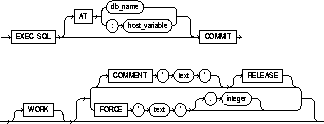
| AT | identifies the database to which the COMMIT statement is issued. The database can be identified by either: | |
| dbname | is a database identifier declared in a previous DECLARE DATABASE statement. | |
| :host_variable | is a host variable whose value is a previously declared db_name. | |
| If you omit this clause, Oracle8 issues the statement to your default database. | ||
| WORK | is supported only for compliance with standard SQL. The statements COMMIT and COMMIT WORK are equivalent. | |
| COMMENT | specifies a comment to be associated with the current transaction. The 'text' is a quoted literal of up to 50 characters that Oracle8 stores in the data dictionary view DBA_2PC_PENDING along with the transaction ID if the transaction becomes in-doubt. | |
| RELEASE | frees all resources and disconnects the application from the Oracle8 Server. | |
| FORCE | manually commits an in-doubt distributed transaction. The transaction is identified by the 'text' containing its local or global transaction ID. To find the IDs of such transactions, query the data dictionary view DBA_2PC_PENDING. You can also use the optional integer to explicitly assign the transaction a system change number (SCN). If you omit the integer, the transaction is committed using the current SCN. | |
Always explicitly commit or rollback the last transaction in your program by using the COMMIT or ROLLBACK command and the RELEASE option. Oracle8 automatically rolls back changes if the program terminates abnormally.
The COMMIT command has no effect on host variables or on the flow of control in the program. For more information on this command, see "Using the COMMIT Statement" on page 8-4.
This example illustrates the use of the embedded SQL COMMIT command:
EXEC SQL AT SALESDB COMMIT RELEASE END-EXEC.
ROLLBACK (Executable Embedded SQL)
SAVEPOINT (Executable Embedded SQL)
To logon to an Oracle8 database.
You must have CREATE SESSION system privilege in the specified database.
If you are using Trusted Oracle in DBMS MAC mode, your operating system label must dominate both your creation label and the label at which you were granted CREATE SESSION system privilege. Your operating system label must also fall between the operating system equivalents of DBHIGH and DBLOW, inclusive.
If you are using Trusted Oracle in OS MAC mode, your operating system label must match the label of the database to which you are connecting.

| :user:password | specifies your username and password separately. | |
| :user_password | is a single host variable containing the Oracle8 username and password seperated by a slash (/).To allow Oracle8 to verify your connection through your operating system, specify "/" as the :user_password value. To allow Oracle8 to verify your connection through your operating system, specify "/" as the :user_password value. | |
| AT | identifies the database to which the connection is made. The database can be identified by either: | |
| db_name | is a database identifier declared in a previous DECLARE DATABASE statement. | |
| :host_variable | is a host variable whose value is a previously declared db_name. | |
| USING | specifies the SQL*Net database specification string used to connect to a non-default database. If you omit this clause, you are connected to your default database. | |
| ALTER AUTHORIZATION | Change password to the following string. | |
| :new_password | New password string. | |
A program can have multiple connections, but can only connect once
to your default database. For more information on this command, see "Embedding OCI (Oracle Call Interface) Calls" on page 4-34.
The following example illustrate the use of CONNECT:
EXEC SQL CONNECT :USERNAME IDENTIFIED BY :PASSWORD END-EXEC.
You can also use this statement in which the value of :userid is the value of :username and :password separated by a "/" such as 'SCOTT/TIGER':
EXEC SQL CONNECT :USERID END-EXEC.
COMMIT (Executable Embedded SQL)
DECLARE DATABASE (Oracle Embedded SQL Directive)
ROLLBACK (Executable Embedded SQL)
To declare a cursor, giving it a name and associating it with a SQL statement or a PL/SQL block.
If you associate the cursor with an identifier for a SQL statement or PL/SQL block, you must have declared this identifier in a previous DECLARE STATEMENT statement.

| AT | i dentifies the database on which the cursor is declared. The database can be identified by either: | |
| db_name | is a database identifier declared in a previous DECLARE DATABASE statement. | |
| :host_variable | is a host variable whose value is a previously declared db_name. | |
| If you omit this clause, Oracle8 declares the cursor on your default database. | ||
| cursor | is the name of the cursor to be declared. | |
| WITH HOLD | cursor remains open after a COMMIT or a ROLLBACK. The cursor must not be declared for UPDATE. | |
| SELECT command | is a SELECT statement to be associated with the cursor. The following statement cannot contain an INTO clause. | |
| statement_nameblock_name | identifies a SQL statement or PL/SQL block to be associated with the cursor. The statement_name or block_name must be previously declared in a DECLARE STATEMENT statement. | |
You must declare a cursor before referencing it in other embedded SQL statements. The scope of a cursor declaration is global within its precompilation unit and the name of each cursor must be unique in its scope. You cannot declare two cursors with the same name in a single precompilation unit.
You can reference the cursor in the WHERE clause of an UPDATE or DELETE statement using the CURRENT OF syntax, provided that the cursor has been opened with an OPEN statement and positioned on a row with a FETCH statement. For more information on this command, see .
This example illustrates the use of a DECLARE CURSOR statement:
EXEC SQL DECLARE EMPCURSOR CURSOR FOR SELECT ENAME, EMPNO, JOB, SAL FROM EMP WHERE DEPTNO = :DEPTNO FOR UPDATE OF SAL END-EXEC.
CLOSE (Executable Embedded SQL)
DECLARE DATABASE (Oracle Embedded SQL Directive)
DECLARE STATEMENT (Embedded SQL Directive)
DELETE (Executable Embedded SQL)
FETCH (Executable Embedded SQL)
OPEN (Executable Embedded SQL)
PREPARE (Executable Embedded SQL)
SELECT (Executable Embedded SQL)
UPDATE (Executable Embedded SQL)
To declare an identifier for a non-default database to be accessed in subsequent embedded SQL statements.
You must have access to a username on the non-default database.

| db_name | is the identifier established for the non-default database. |
You declare a db_name for a non-default database so that other embedded SQL statements can refer to that database using the AT clause. Before issuing a CONNECT statement with an AT clause, you must declare a db_name for the non-default database with a DECLARE DATABASE statement.
For more information on this command, see "Explicit Logons" on page 3-47.
This example illustrates the use of a DECLARE DATABASE directive:
EXEC SQL DECLARE ORACLE3 DATABASE END-EXEC.
COMMIT (Executable Embedded SQL)
CONNECT (Executable Embedded SQL Extension)
DECLARE CURSOR (Embedded SQL Directive)
DECLARE STATEMENT (Embedded SQL Directive)
DELETE (Executable Embedded SQL)
EXECUTE (Executable Embedded SQL)
EXECUTE IMMEDIATE (Executable Embedded SQL)
INSERT (Executable Embedded SQL)
SELECT (Executable Embedded SQL)
UPDATE (Executable Embedded SQL)
To declare an identifier for a SQL statement or PL/SQL block to be used in other embedded SQL statements.
None.
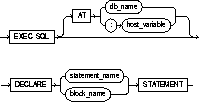
| AT | identifies the database on which the SQL statement or PL/SQL block is declared. The database can be identified by either: | |
| db_name | is a database identifier declared in a previous DECLARE DATABASE statement. | |
| :host_variable | is a host variable whose value is a previously declared db_name. | |
| If you omit this clause, Oracle8 declares the SQL statement or PL/SQL block on your default database. | ||
| statement_name | is the declared identifier for the statement. | |
| block_name | PL/SQL block | |
You must declare an identifier for a SQL statement or PL/SQL block with a DECLARE STATEMENT statement only if a DECLARE CURSOR statement referencing the identifier appears physically (not logically) in the embedded SQL program before the PREPARE statement that parses the statement or block and associates it with its identifier.
The scope of a statement declaration is global within its precompilation unit, like a cursor declaration. For more information on this command, see "DECLARE" on page 11-20.
This example illustrates the use of the DECLARE STATEMENT statement:
EXEC SQL AT REMOTEDB DECLARE MYSTATEMENT STATEMENT END-EXEC. EXEC SQL PREPARE MYSTATEMENT FROM :MY-STRING END-EXEC. EXEC SQL EXECUTE MYSTATEMENT END-EXEC.
In this example from a Pro*COBOL embedded SQL program, the DECLARE STATEMENT statement is required because the DECLARE CURSOR statement precedes the PREPARE statement:
EXEC SQL DECLARE MYSTATEMENT STATEMENT END-EXEC. EXEC SQL DECLARE EMPCURSOR CURSOR FOR MYSTATEMENT END-EXEC. EXEC SQL PREPARE MYSTATEMENT FROM :MY-STRING END-EXEC. ...
CLOSE (Executable Embedded SQL)
DECLARE DATABASE (Oracle Embedded SQL Directive)
FETCH (Executable Embedded SQL)
PREPARE (Executable Embedded SQL)
OPEN (Executable Embedded SQL)
To define the structure of a table or view, including each column's datatype, default value, and NULL or NOT NULL specification for semantic checking by the precompiler when option SQLCHECK=SEMANTICS (or FULL).
None.
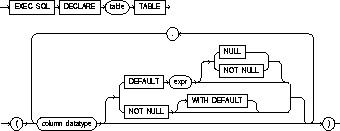
| table | is the name of the declared table. |
| column | is a column of the table. |
| datatype | is the datatype of a column. For information on Oracle8 datatypes, see Chapter 4. |
| DEFAULT | specifies the default value of a column. |
| NULL | specifies that a column can contain nulls. |
| NOT NULL | specifies that a column cannot contain nulls. |
| WITH DEFAULT | is supported for compatibility with the IBM DB2 database. |
Datatypes can only use integers (not expressions) for length, precision, scale. For more information on using this command, see "Specifying SQLCHECK=SEMANTICS" on page E-3.
The following statement declares the PARTS table with the PARTNO, BIN, and QTY columns:
EXEC SQL DECLARE PARTS TABLE (PARTNO NUMBER NOT NULL, BIN NUMBER, QTY NUMBER) END-EXEC.
None.
To remove rows from a table or from a view's base table.
For you to delete rows from a table, the table must be in your own schema or you must have DELETE privilege on the table.
For you to delete rows from the base table of a view, the owner of the schema containing the view must have DELETE privilege on the base table. Also, if the view is in a schema other than your own, you must be granted DELETE privilege on the view.
The DELETE ANY TABLE system privilege also allows you to delete rows from any table or any view's base table.
If you are using Trusted Oracle in DBMS MAC mode, your DBMS label must dominate the creation label of the table or view or you must meet one of the following criteria:
In addition, for each row to be deleted, your DBMS label must match the row's label or you must meet one of the following criteria:

 Keywords and Parameters
Keywords and Parameters| AT | identifies the database to which the DELETE statement is ssued. The database can be identified by either: | |
| db_name | is a database identifier declared in a previous DECLARE DATABASE statement. | |
| :host_variable | is a host variable whose value is a previously declared db_name. | |
| If you omit this clause, the DELETE statement is issued to your default database. | ||
| FOR :host_integer | limits the number of times the statement is executed if the WHERE clause contains array host variables. If you omit this clause, Oracle8 executes the statement once for each component of the smallest array. | |
| schema | is the schema containing the table or view. If you omit schema, Oracle8 assumes the table or view is in your own schema. | |
| table view | is the name of a table from which the rows are to be deleted. If you specify view, Oracle8 deletes rows from the view's base table. | |
| dblink | is the complete or partial name of a database link to a remote database where the table or view is located. For information on referring to database links, see Chapter 2 of the Oracle8 SQL Reference. You can only delete rows from a remote table or view if you are using Oracle8 with the distributed option. If you omit dblink, Oracle8 assumes that the table or view is located on the local database. | |
| part_name | name of partition in the table | |
| alias | is an alias assigned to the table. Aliases are generally used in DELETE statements with correlated queries. | |
| WHERE | specifies which rows are deleted: | |
| condition | deletes only rows that satisfy the condition. This condition can contain host variables and optional indicator variables. See the syntax description of condition in the Oracle8 SQL Reference. | |
| CURRENT OF | deletes only the row most recently fetched by the cursor. The cursor cannot be associated with a SELECT statement that performs a join, unless its FOR UPDATE clause specifically locks only one table. | |
| If you omit this clause entirely, Oracle8 deletes all rows from the table or view. | ||
The host variables in the WHERE clause must be either all scalars or all arrays. If they are scalars, Oracle8 executes the DELETE statement only once. If they are arrays, Oracle8 executes the statement once for each set of array components. Each execution may delete zero, one, or multiple rows.
Array host variables in the WHERE clause can have different sizes. In this case, the number of times Oracle8 executes the statement is determined by the smaller of the following values:
If no rows satisfy the condition, no rows are deleted and the SQLCODE returns a NOT_FOUND condition.
The cumulative number of rows deleted is returned through the SQLCA. If the WHERE clause contains array host variables, this value reflects the total number of rows deleted for all components of the array processed by the DELETE statement.
If no rows satisfy the condition, Oracle8 returns an error through the SQLCODE of the SQLCA. If you omit the WHERE clause, Oracle8 raises a warning flag in the fifth component of SQLWARN in the SQLCA. For more information on this command and the SQLCA, see "Using the SQL Communications Area" on page 9-19.
You can use comments in a DELETE statement to pass instructions, or hints, to the Oracle8 optimizer. The optimizer uses hints to choose an execution plan for the statement. For more information on hints, see Oracle8 Tuning.
This example illustrates the use of the DELETE statement within a Pro*COBOL embedded SQL program:
EXEC SQL DELETE FROM EMP WHERE DEPTNO = :DEPTNO AND JOB = :JOB END-EXEC. EXEC SQL DECLARE EMPCURSOR CURSOR FOR SELECT EMPNO, COMM FROM EMP END-EXEC. EXEC SQL OPEN EMPCURSOR END-EXEC. EXEC SQL FETCH EMPCURSOR INTO :EMP-NUMBER, :COMMISSION END-EXEC. EXEC SQL DELETE FROM EMP WHERE CURRENT OF EMPCURSOR END-EXEC.
DECLARE DATABASE (Oracle Embedded SQL Directive)
DECLARE STATEMENT (Embedded SQL Directive)
To initialize a descriptor to hold descriptions of host variables for a dynamic SQL statement or PL/SQL block.
You must have prepared the SQL statement or PL/SQL block in a previous embedded SQL PREPARE statement.
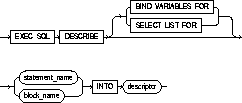
| BIND VARIABLES | initializes the descriptor to hold information about the input variables for the SQL statement or PL/SQL block. |
| SELECT LIST | initializes the descriptor to hold information about the select list of a SELECT statement. |
| The default is SELECT LIST FOR. | |
| statement_name block_name | identifies a SQL statement or PL/SQL block previously prepared with a PREPARE statement. |
| descriptor | is the name of the descriptor to be initialized. |
You must issue a DESCRIBE statement before manipulating the bind or select descriptor within an embedded SQL program.
You cannot describe both input variables and output variables into the same descriptor.
The number of variables found by a DESCRIBE statement is the total number of placeholders in the prepare SQL statement or PL/SQL block, rather than the total number of uniquely named placeholders. For more information on this command, see "The DESCRIBE Statement" on page 11-26.
This example illustrates the use of the DESCRIBE statement in a Pro*COBOL embedded SQL program:
EXEC SQL PREPARE MYSTATEMENT FROM :MY-STRING END-EXEC. EXEC SQL DECLARE EMPCURSOR FOR SELECT EMPNO, ENAME, SAL, COMM FROM EMP WHERE DEPTNO = :DEPT-NUMBER END-EXEC. EXEC SQL DESCRIBE BIND VARIABLES FOR MYSTATEMENT INTO BINDDESCRIPTOR END-EXEC. EXEC SQL OPEN EMPCURSOR USING BINDDESCRIPTOR END-EXEC. EXEC SQL DESCRIBE SELECT LIST FOR MY-STATEMENT INTO SELECTDESCRIPTOR END-EXEC. EXEC SQL FETCH EMPCURSOR INTO SELECTDESCRIPTOR END-EXEC.
PREPARE (Executable Embedded SQL)
To embed an anonymous PL/SQL block into an Oracle Pro*COBOL program.
None.

| AT | identifies the database on which the PL/SQL block is executed. The database can be identified by either: | |
| db_name | is a database identifier declared in a previous DECLARE DATABASE statement. | |
| :host_variable | is a host variable whose value is a previously declared db_name. | |
| If you omit this clause, the PL/SQL block is executed on your default database. | ||
| pl/sql_block | For information on PL/SQL, including how to write PL/SQL blocks, see the PL/SQL User's Guide and Reference. | |
| END-EXEC | must appear after the embedded PL/SQL block. The keyword END-EXEC must be followed by the statement terminator for COBOL, ".". | |
Since the Oracle Precompilers treat an embedded PL/SQL block like a single embedded SQL statement, you can embed a PL/SQL block anywhere in an Oracle Precompiler program that you can embed a SQL statement. For more information on embedding PL/SQL blocks in Oracle Precompiler programs, see Chapter 6, "Using Embedded PL/SQL".
Placing this EXECUTE statement in an Oracle Precompiler program embeds a PL/SQL block in the program:
EXEC SQL EXECUTE BEGIN SELECT ENAME, JOB, SAL INTO :EMP-NAME:IND-NAME, :JOB-TITLE, :SALARY FROM EMP WHERE EMPNO = :EMP-NUMBER; IF :EMP-NAME:IND-NAME IS NULL THEN RAISE NAME-MISSING; END IF; END; END-EXEC.
EXECUTE IMMEDIATE (Executable Embedded SQL)
To execute a DELETE, INSERT, or UPDATE statement or a PL/SQL block that has been previously prepared with an embedded SQL PREPARE statement.
You must first prepare the SQL statement or PL/SQL block with an embedded SQL PREPARE statement.
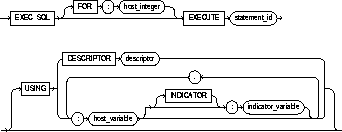
| FOR :host_integer | limits the number of times the statement is executed when the USING clause contains array host variables If you omit this clause, Oracle8 executes the statement once for each component of the smallest array. |
| statement_id | is a precompiler identifier associated with the SQL statement or PL/SQL block to be executed. Use the embedded SQL PREPARE command to associate the precompiler identifier with the statement or PL/SQL block. |
| USING | specifies a list of host variables with optional indicator variables that Oracle8 substitutes as input variables into the statement to be executed. The host and indicator variables must be either all scalars or all arrays. |
For more information on this command, see Chapter 11, "Using Dynamic SQL".
This example illustrates the use of the EXECUTE statement in a Pro*COBOL embedded SQL program:
EXEC SQL PREPARE MY-STATEMENT FROM MY-STRING END-EXEC. EXEC SQL EXECUTE MY-STATEMENT USING :MY-VAR END-EXEC.
DECLARE DATABASE (Oracle Embedded SQL Directive)
PREPARE (Executable Embedded SQL)
To prepare and execute a DELETE, INSERT, or UPDATE statement or a PL/SQL block containing no host variables.
None.

| AT | identifies the database on which the SQL statement or PL/SQL block is executed. The database can be identified by either: | |
| db_name | is a database identifier declared in a previous DECLARE DATABASE statement. | |
| :host_variable | is a host variable whose value is a previously declared db_name. | |
| If you omit this clause, the statement or block is executed on your default database. | ||
| :host_string | is a host variable whose value is the SQL statement or PL/SQL block to be executed. | |
| text | is a quoted text literal containing the SQL statement or PL/SQL block to be executed. | |
| The SQL statement can only be a DELETE, INSERT, or UPDATE statement. | ||
When you issue an EXECUTE IMMEDIATE statement, Oracle8 parses the specified SQL statement or PL/SQL block, checking for errors, and executes it. If any errors are encountered, they are returned in the SQLCODE component of the SQLCA.
For more information on this command, see "The EXECUTE IMMEDIATE Statement" on page 11-9.
This example illustrates the use of the EXECUTE IMMEDIATE statement:
EXEC SQL EXECUTE IMMEDIATE 'DELETE FROM EMP WHERE EMPNO = 9460' END-EXEC.
PREPARE (Executable Embedded SQL)
EXECUTE (Executable Embedded SQL)
To retrieve one or more rows returned by a query, assigning the select list values to host variables.
You must first open the cursor with an the OPEN statement.
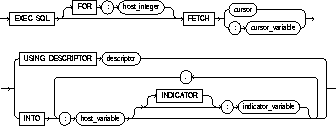
| FOR :host_integer | limits the number of rows fetched if you are using array host variables. If you omit this clause, Oracle8 fetches enough rows to fill the smallest array. |
| cursor | is a cursor that is declared by a DECLARE CURSOR statement. The FETCH statement returns one of the rows selected by the query associated with the cursor. |
| :cursor_variable | is a cursor variable is allocated an ALLOCATE statement. The FETCH statement returns one of the rows selected by the query associated with the cursor variable. |
| INTO | specifies a list of host variables and optional indicator variables into which data is fetched. These host variables and indicator variables must be declared within the program. |
| USING | specifies the descriptor referenced in a previous DESCRIBE statement. Only use this clause with dynamic embedded SQL, method 4. Also, the USING clause does not apply when a cursor variable is used. |
The FETCH statement reads the rows of the active set and names the output variables which contain the results. Indicator values are set to -1 if their associated host variable is null. The first FETCH statement for a cursor also sorts the rows of the active set, if necessary.
The number of rows retrieved is specified by the size of the output host variables and the value specified in the FOR clause. The host variables to receive the data must be either all scalars or all arrays. If they are scalars, Oracle8 fetches only one row. If they are arrays, Oracle8 fetches enough rows to fill the arrays.
Array host variables can have different sizes. In this case, the number of rows Oracle8 fetches is determined by the smaller of the following values:
Of course, the number of rows fetched can be further limited by the number of rows that actually satisfy the query.
If a FETCH statement does not retrieve all rows returned by the query, the cursor is positioned on the next returned row. When the last row returned by the query has been retrieved, the next FETCH statement results in an error code returned in the SQLCODE element of the SQLCA.
Note that the FETCH command does not contain an AT clause. You must specify the database accessed by the cursor in the DECLARE CURSOR statement.
You can only move forward through the active set with FETCH statements. If you want to revisit any of the previously fetched rows, you must reopen the cursor and fetch each row in turn. If you want to change the active set, you must assign new values to the input host variables in the cursor's query and reopen the cursor.
This example illustrates the FETCH command in a Pro*COBOL embedded SQL program:
EXEC SQL DECLARE EMPCURSOR CURSOR FOR SELECT JOB, SAL FROM EMP WHERE DEPTNO = 30 END-EXEC. ... EXEC SQL WHENEVER NOT FOUND GOTO ... LOOP. EXEC SQL FETCH EMPCURSOR INTO :JOB-TITLE1, :SALARY1 END-EXEC. EXEC SQL FETCH EMPCURSOR INTO :JOB-TITLE2, :SALARY2 END-EXEC. ... GO TO LOOP. ...
PREPARE (Executable Embedded SQL)
DECLARE CURSOR (Embedded SQL Directive)
OPEN (Executable Embedded SQL)
CLOSE (Executable Embedded SQL)
To add rows to a table or to a view's base table.
For you to insert rows into a table, the table must be in your own schema or you must have INSERT privilege on the table.
For you to insert rows into the base table of a view, the owner of the schema containing the view must have INSERT privilege on the base table. Also, if the view is in a schema other than your own, you must have INSERT privilege on the view.
The INSERT ANY TABLE system privilege also allows you to insert rows into any table or any view's base table.
If you are using Trusted Oracle in DBMS MAC mode, your DBMS label must match the creation label of the table or view:
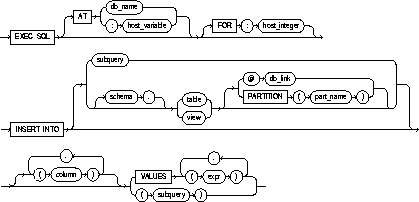
| AT | identifies the database on which the INSERT statement is executed. The database can be identified by either: | |
| db_name | is a database identifier declared in a previous DECLARE DATABASE statement. | |
| :host_variable | is a host variable whose value is a previously declared db_name | |
| If you omit this clause, the INSERT statement is executed on your default database. | ||
| FOR :host_integer | limits the number of times the statement is executed if the VALUES clause contains array host variables. If you omit this clause, Oracle8 executes the statement once for each component in the smallest array. | |
| schema | is the schema containing the table or view. If you omit schema, Oracle8 assumes the table or view is in your own schema. | |
| table view | is the name of the table into which rows are to be inserted. If you specify view, Oracle8 inserts rows into the view's base table. | |
| db_link | is a complete or partial name of a database link to a remote database where the table or view is located. For information on referring to database links, see the Oracle8 SQL Reference. You can only insert rows into a remote table or view if you are using Oracle8 with the distributed option. If you omit dblink, Oracle8 assumes that the table or view is on the local database. | |
| part_name | name of partition in the table | |
| column | is a column of the table or view. In the inserted row, each column in this list is assigned a value from the VALUES clause or the query. If you omit one of the table's columns from this list, the column's value for the inserted row is the column's default value as specified when the table was created. If you omit the column list altogether, the VALUES clause or query must specify values for all columns in the table. | |
| VALUES | specifies a row of values to be inserted into the table or view. See the syntax description of expr in the Oracle8 SQL Reference Note that the expressions can be host variables with optional indicator variables. You must specify an expression in the VALUES clause for each column in the column list. | |
| subquery | is a subquery that returns rows that are inserted into the table. The select list of this subquery must have the same number of columns as the column list of the INSERT statement. For the syntax description of a subquery, see "SELECT" in the Oracle8 SQL Reference. | |
Any host variables that appear in the WHERE clause must be either all scalars or all arrays. If they are scalars, Oracle8 executes the INSERT statement once. If they are arrays, Oracle8 executes the INSERT statement once for each set of array components, inserting one row each time.
Array host variables in the WHERE clause can have different sizes. In this case, the number of times Oracle8 executes the statement is determined by the smaller of the following values:
For more information on this command, see "The Basic SQL Statements" on page 5-7.
This example illustrates the use of the embedded SQL INSERT command:
EXEC SQL INSERT INTO EMP (ENAME, EMPNO, SAL) VALUES (:ENAME, :EMPNO, :SAL) END-EXEC.
This example shows an embedded SQL INSERT command with a subquery:
EXEC SQL INSERT INTO NEWEMP (ENAME, EMPNO, SAL) SELECT ENAME, EMPNO, SAL FROM EMP WHERE DEPTNO = :DEPTNO END-EXEC.
DECLARE DATABASE (Oracle Embedded SQL Directive)
To open a cursor, evaluating the associated query and substituting the host variable names supplied by the USING clause into the WHERE clause of the query.
You must declare the cursor with a DECLARE CURSOR embedded SQL statement before opening it.
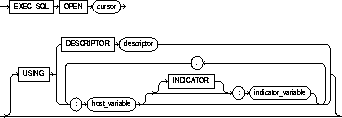
| cursor | is the cursor to be opened. |
| USING | specifies the host variables to be substituted into the WHERE clause of the associated query. |
| :host_variable | specifies a host variable with an optional indicator variable to be substituted into the statement associated with the cursor. |
| DESCRIPTOR | specifies a descriptor that describes the host variables to be substituted into the WHERE clause of the associated query. The descriptor must be initialized in a previous DESCRIBE statement. The substitution is based on position. The host variable names specified in this statement can be different from the variable names in the associated query. |
The OPEN command defines the active set of rows and initializes the cursor just before the first row of the active set. The values of the host variables at the time of the OPEN are substituted in the statement. This command does not actually retrieve rows; rows are retrieved by the FETCH command.
Once you have opened a cursor, its input host variables are not reexamined until you reopen the cursor. To change any input host variables and therefore the active set, you must reopen the cursor.
All cursors in a program are in a closed state when the program is initiated or when they have been explicitly closed using the CLOSE command.
You can reopen a cursor without first closing it. For more information on this command, see "Opening a Cursor" on page 5-12.
This example illustrates the use of the OPEN command in a Pro*COBOL embedded SQL program:
EXEC SQL DECLARE EMPCURSOR CURSOR FOR SELECT ENAME, EMPNO, JOB, SAL FROM EMP WHERE DEPTNO = :DEPTNO END-EXEC. EXEC SQL OPEN EMPCURSOR END-EXEC.
PREPARE (Executable Embedded SQL)
DECLARE CURSOR (Embedded SQL Directive)
FETCH (Executable Embedded SQL)
CLOSE (Executable Embedded SQL)
To parse a SQL statement or PL/SQL block specified by a host variable and associate it with an identifier.
None.

| statement_id | is the identifier to be associated with the prepared SQL statement or PL/SQL block. If this identifier was previously assigned to another statement or block, the prior assignment is superseded. |
| :host_string | is a host variable whose value is the text of a SQL statement or PL/SQL block to be prepared. |
| text | is a string literal containing a SQL statement or PL/SQL block to be prepared. |
| select_command | is a SELECT command. |
Any variables that appear in the :host_string or text are placeholders. The actual host variable names are assigned in the USING clause of the OPEN command (input host variables) or in the INTO clause of the FETCH command (output host variables).
A SQL statement is prepared only once, but can be executed any number of times.
This example illustrates the use of a PREPARE statement in a Pro*COBOL embedded SQL program:
EXEC SQL PREPARE MYSTATEMENT FROM :MY-STRING END-EXEC. EXEC SQL EXECUTE MYSTATEMENT END-EXEC.
DECLARE CURSOR (Embedded SQL Directive)
OPEN (Executable Embedded SQL)
FETCH (Executable Embedded SQL)
CLOSE (Executable Embedded SQL)
To undo work done in the current transaction. You can also use this command to manually undo the work done by an in-doubt distributed transaction.
To roll back your current transaction, no privileges are necessary.
To manually roll back an in-doubt distributed transaction that you originally committed, you must have FORCE TRANSACTION system privilege. To manually roll back an in-doubt distributed transaction originally committed by another user, you must have FORCE ANY TRANSACTION system privilege.
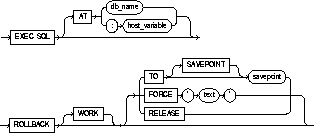
| WORK | is optional and is provided for ANSI compatibility. |
| TO | rolls back the current transaction to the specified savepoint. If you omit this clause, the ROLLBACK statement rolls back the entire transaction. |
| FORCE | manually rolls back an in-doubt distributed transaction. The transaction is identified by the text containing its local or global transaction ID. To find the IDs of such transactions, query the data dictionary view DBA_2PC_PENDING. ROLLBACK statements with the FORCE clause are not supported in PL/SQL. |
| RELEASE | frees all resources and disconnects the application from the Oracle8 Server. The RELEASE clause is not allowed with SAVEPOINT and FORCE clauses. |
A transaction (or a logical unit of work) is a sequence of SQL statements that Oracle8 treats as a single unit. A transaction begins with the first executable SQL statement after a COMMIT, ROLLBACK or connection to the database. A transaction ends with a COMMIT statement, a ROLLBACK statement, or disconnection (intentional or unintentional) from the database. Note that Oracle8 issues an implicit COMMIT statement before and after processing any Data Definition Language statement.
Using the ROLLBACK command without the TO SAVEPOINT clause performs the following operations:
Using the ROLLBACK command with the TO SAVEPOINT clause performs the following operations:
It is recommended that you explicitly end transactions in application programs using either a COMMIT or ROLLBACK statement. If you do not explicitly commit the transaction and the program terminates abnormally, Oracle8 rolls back the last uncommitted transaction.
The following statement rolls back your entire current transaction:
EXEC SQL ROLLBACK END-EXEC.
The following statement rolls back your current transaction to savepoint SP5:
EXEC SQL ROLLBACK TO SAVEPOINT SP5 END-EXEC.
Oracle8 with the distributed option allows you to perform distributed transactions, or transactions that modify data on multiple databases. To commit or roll back a distributed transaction, you need only issue a COMMIT or ROLLBACK statement as you would any other transaction.
If there is a network failure during the commit process for a distributed transaction, the state of the transaction may be unknown, or in-doubt. After consultation with the administrators of the other databases involved in the transaction, you may decide to manually commit or roll back the transaction on your local database. You can manually roll back the transaction on your local database by issuing a ROLLBACK statement with the FORCE clause.
For more information on when to roll back in-doubt transactions, see Oracle8 Distributed Database Systems.
You cannot manually roll back an in-doubt transaction to a savepoint.
A ROLLBACK statement with a FORCE clause only rolls back the specified transaction. Such a statement does not affect your current transaction.
The following statement manually rolls back an in-doubt distributed transaction:
EXEC SQL ROLLBACK WORK FORCE '25.32.87' END-EXEC.
COMMIT (Executable Embedded SQL)
SAVEPOINT (Executable Embedded SQL)
To identify a point in a transaction to which you can later roll back.
None.

| AT | identifies the database on which the savepoint is created. The database can be identified by either: | |
| db_name | is a database identifier declared in a previous DECLARE DATABASE statement. | |
| :host_variable | is a host variable whose value is a previously declared db_name. | |
| If you omit this clause, the savepoint is created on your default database. | ||
| savepoint | is the name of the savepoint to be created. | |
For more information on this command, see "Using the SAVEPOINT Statement" on page 8-7.
This example illustrates the use of the embedded SQL SAVEPOINT command:
EXEC SQL SAVEPOINT SAVE3 END-EXEC.
COMMIT (Executable Embedded SQL)
ROLLBACK (Executable Embedded SQL)
To retrieve data from one or more tables, views, or snapshots, assigning the selected values to host variables.
For you to select data from a table or snapshot, the table or snapshot must be in your own schema or you must have SELECT privilege on the table or snapshot.
For you to select rows from the base tables of a view, the owner of the schema containing the view must have SELECT privilege on the base tables. Also, if the view is in a schema other than your own, you must have SELECT privilege on the view.
The SELECT ANY TABLE system privilege also allows you to select data from any table or any snapshot or any view's base table.
If you are using Trusted Oracle in DBMS MAC mode, your DBMS label must dominate the creation label of each queried table, view, or snapshot or you must have READUP system privileges.

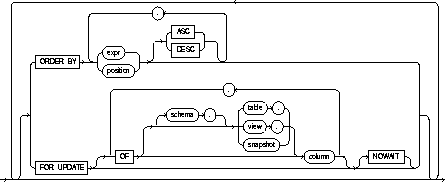
| AT | identifies the database to which the SELECT statement is issued. The database can be identified by either: | |
| db_name | is a database identifier declared in a previous DECLARE DATABASE statement. | |
| :host_variable | is a host variable whose value is a previously declared db_name. | |
| If you omit this clause, the SELECT statement is issued to your default database. | ||
| select_list | identical to the non-embedded SELECT command except that a host variables can be used in place of literals. | |
| INTO | specifies output host variables and optional indicator variables to receive the data returned by the SELECT statement. Note that these variables must be either all scalars or all arrays, but arrays need not have the same size. | |
| WHERE | restricts the rows returned to those for which the condition is TRUE. See the syntax description of condition in the Oracle8 SQL Reference. The condition can contain host variables, but cannot contain indicator variables. These host variables can be either scalars or arrays. | |
If no rows meet the WHERE clause condition, no rows are retrieved and Oracle8 returns an error code through the SQLCODE component of the SQLCA.
You can use comments in a SELECT statement to pass instructions, or hints, to the Oracle8 optimizer. The optimizer uses hints to choose an execution plan for the statement. For more information on hints, see Oracle8 Tuning.
This example illustrates the use of the embedded SQL SELECT command:
EXEC SQL SELECT ENAME, SAL + 100, JOB INTO :ENAME, :SAL, :JOB FROM EMP WHERE EMPNO = :EMPNO END-EXEC.
DECLARE DATABASE (Oracle Embedded SQL Directive)
DECLARE CURSOR (Embedded SQL Directive)
EXECUTE (Executable Embedded SQL)
FETCH (Executable Embedded SQL)
PREPARE (Executable Embedded SQL)
To change existing values in a table or in a view's base table.
For you to update values in a table or snapshot, the table must be in your own schema or you must have UPDATE privilege on the table.
For you to update values in the base table of a view, the owner of the schema containing the view must have UPDATE privilege on the base table. Also, if the view is in a schema other than your own, you must have UPDATE privilege on the view.
The UPDATE ANY TABLE system privilege also allows you to update values in any table or any view's base table.
If you are using Trusted Oracle in DBMS MAC mode, your DBMS label must match the creation label of the table or view:
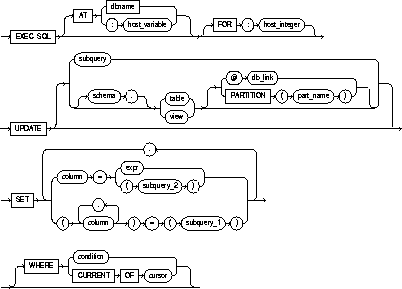
| AT | identifies the database to which the UPDATE statement is issued. The database can be identified by either: | |
| dbname | is a database identifier declared in a previous DECLARE DATABASE statement. | |
| :host_variable | is a host variable whose value is a previously declared dbname. | |
| If you omit this clause, the UPDATE statement is issued to your default database. | ||
| FOR :host_integer | limits the number of times the UPDATE statement is executed if the SET and WHERE clauses contain array host variables. If you omit this clause, Oracle8 executes the statement once for each component of the smallest array. | |
| schema | is the schema containing the table or view. If you omit schema, Oracle8 assumes the table or view is in your own schema. | |
| table view | is the name of the table to be updated. If you specify view, Oracle8 updates the view's base table. | |
| dblink | is a complete or partial name of a database link to a remote database where the table or view is located. For information on referring to database links, see the Oracle8 SQL Reference. You can only use a database link to update a remote table or view if you are using Oracle8 with the distributed option. | |
| part_name | name of partition in the table | |
| alias | is a name used to reference the table, view, or subquery elsewhere in the statement. | |
| column | is the name of a column of the table or view that is to be updated. If you omit a column of the table from the SET clause, that column's value remains unchanged. | |
| expr | is the new value assigned to the corresponding column. This expression can contain host variables and optional indicator variables. See the syntax of expr in the Oracle8 SQL Reference. | |
| subquery_1 | is a subquery that returns new values that are assigned to the corresponding columns. For the syntax of a subquery, see "SELECT" in the Oracle8 SQL Reference. | |
| subquery_2 | is a subquery that return a new value that is assigned to the corresponding column. For the syntax of a subquery, see "SELECT" in the Oracle8 SQL Reference. | |
| WHERE | specifies which rows of the table or view are updated: | |
| condition | updates only rows for which this condition is true. This condition can contain host variables and optional indicator variables. See the syntax of condition in the Oracle8 SQL Reference. | |
| CURRENT OF | updates only the row most recently fetched by the cursor. The cursor cannot be associated with a SELECT statement that performs a join unless its FOR UPDATE clause explicitly locks only one table. | |
| If you omit this clause entirely, Oracle8 updates all rows of the table or view. | ||
Host variables in the SET and WHERE clauses must be either all
scalars or all arrays. If they are scalars, Oracle8 executes the UPDATE statement only once. If they are arrays, Oracle8 executes the statement once for each set of array components. Each execution may update zero, one, or multiple rows.
Array host variables can have different sizes. In this case, the number of times Oracle8 executes the statement is determined by the smaller
of the following values:
The cumulative number of rows updated is returned through the third element of the SQLERRD component of the SQLCA. When arrays are used as input host variables, this count reflects the total number of updates for all components of the array processed in the UPDATE statement. If no rows satisfy the condition, no rows are updated and Oracle8 returns an error message through the SQLCODE element of
the SQLCA. If you omit the WHERE clause, all rows are updated and Oracle8 raises a warning flag in the fifth component of the SQLWARN element of the SQLCA.
You can use comments in an UPDATE statement to pass instructions, or hints, to the Oracle8 optimizer. The optimizer uses hints to choose an execution plan for the statement. For more information on hints, see Oracle8 Tuning.
For more information on this command, see "The Basic SQL Statements" on page 5-7 andChapter 8, "Defining and Controlling Transactions".
The following examples illustrate the use of the embedded SQL UPDATE command:
EXEC SQL UPDATE EMP SET SAL = :SAL, COMM = :COMM INDICATOR :COMM-IND WHERE ENAME = :ENAME END-EXEC. EXEC SQL UPDATE EMP SET (SAL, COMM) = (SELECT AVG(SAL)*1.1, AVG(COMM)*1.1 FROM EMP) WHERE ENAME = 'JONES' END-EXEC.
DECLARE DATABASE (Oracle Embedded SQL Directive)
To perform host variable equivalencing, or to assign a specific Oracle8 external datatype to an individual host variable, overriding the default datatype assignment. There is an optional clause,CONVBUFSZ , that specifies the size of a buffer for character set conversion.
The host variable must be previously declared in the embedded SQL program.

 Keywords and Parameters
Keywords and Parameters | host_variable | is the host variable to be assigned an Oracle8 external datatype. |
| dtyp | is an Oracle8 external datatype recognized by the Oracle Precompilers (not an Oracle8 internal datatype). The datatype may include a length, precision, or scale. This external datatype is assigned to the host_variable. For a list of external datatypes, see "External Datatypes" on page 4-9.. |
| size | is the size in bytes of a buffer in the Oracle8 runtime library used to perform conversion between character sets of the host_variable |
Host variable equivalencing is one kind of datatype equivalencing. Datatype equivalencing is useful for any of the following purposes:
For more information about Oracle datatypes, see "External Datatypes" on page 4-9 and "Sample Program 4: Datatype Equivalencing" on page 5-19.
This example equivalences the host variable DEPT_NAME to
the datatype STRING and the host variable BUFFER to the
datatype RAW(200):
EXEC SQL BEGIN DECLARE SECTION END-EXEC. ... 01 DEPT-NAME PIC X(15). * -- default datatype is CHAR EXEC SQL VAR DEPT-NAME IS STRING END-EXEC. * -- reset to STRING ... 01 BUFFER-VAR. 05 BUFFER PIC X(200). * -- default datatype is CHAR EXEC SQL VAR BUFFER IS RAW(200) END-EXEC. * -- refer to RAW ... EXEC SQL END DECLARE SECTION END-EXEC.
None.
To specify the action to be taken when an error or warning results from executing an embedded SQL program.
None.

| NOT FOUND | NOTFOUND | identifies any exception condition that returns an error code of +1403 to SQLCODE (or a +100 code when MODE=ANSI). |
| SQLERROR | identifies a condition that results in a negative return code. |
| SQLWARNING | identifies a non-fatal warning condition. |
| CONTINUE | indicates that the program should progress to the next statement. |
| GOTO | GO TO | indicates that the program should branch to the statement named by label. |
| STOP | stops program execution. |
| DO PERFORM | indicates that the program should perform a routine at label. |
The WHENEVER command allows your program to transfer control to an error handling routine in the event an embedded SQL statement results in an error or warning.
The scope of a WHENEVER statement is positional, rather than logical. A WHENEVER statement applies to all embedded SQL statements that textually follow it in the source file, not in the flow of the program logic. A WHENEVER statement remains in effect until it is superseded by another WHENEVER statement checking for the same condition.
For more information on this command, see Chapter 8, "Defining and Controlling Transactions". Do not confuse the WHENEVER embedded SQL command with the WHENEVER SQL*Plus command.
The following example illustrates the use of the WHENEVER command in a Pro*COBOL embedded SQL program:
EXEC SQL WHENEVER NOT FOUND CONTINUE END-EXEC. ... EXEC SQL WHENEVER SQLERROR GOTO SQL-ERROR END-EXEC. ... SQL-ERROR. EXEC SQL WHENEVER SQLERROR CONTINUE END-EXEC. DISPLAY "ORACLE ERROR DETECTED.". EXEC SQL ROLLBACK RELEASE END-EXEC. STOP RUN.
None